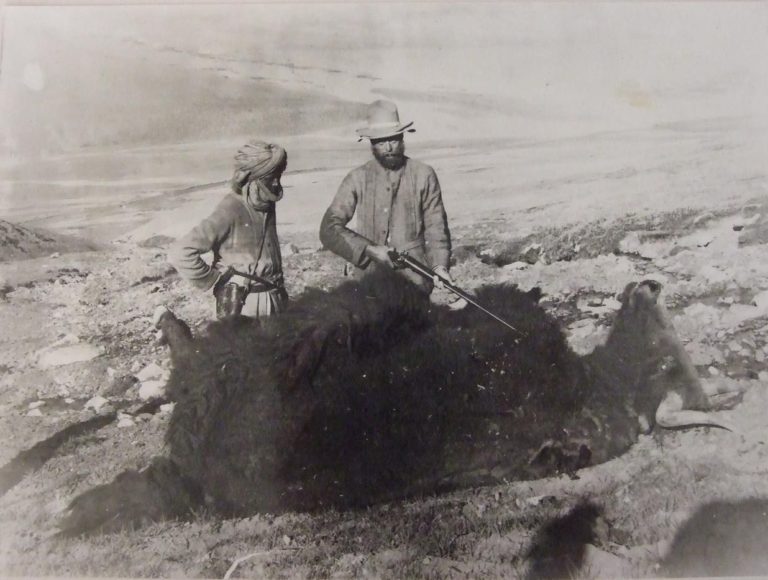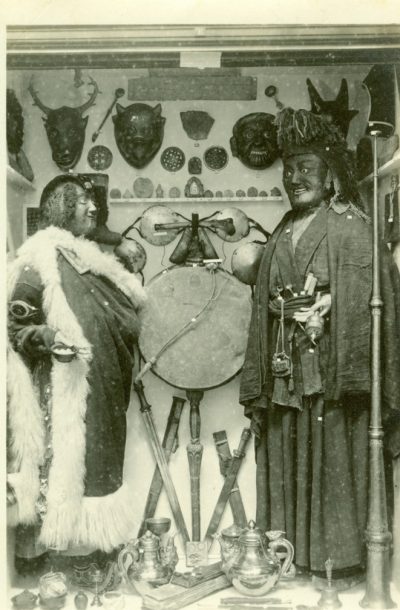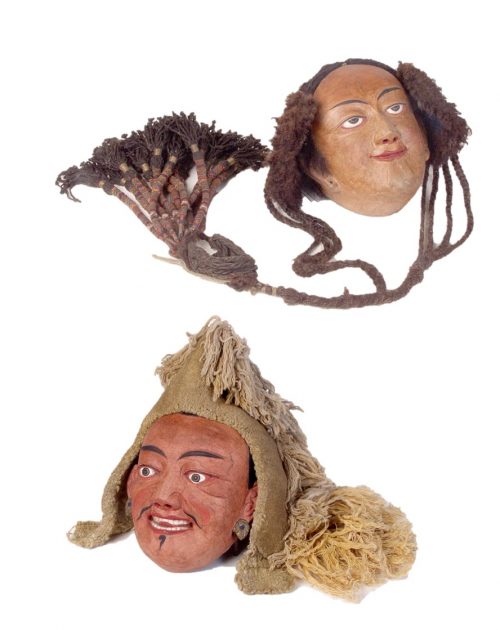Objects and Props: The Story of Two Tibetan Masks
Dr. Inbal Livne, former Head of Collections and Engagement, has been researching two items with a hidden history in the Museum’s Tibetan collection.
In the late 1880s Percy Horace Gordon Powell-Cotton undertook a World Tour. Between 1889-1891 he visited Europe, Asia and North America. As part of his tour of Asia, he spent several months hunting in Kashmir and living in culturally Tibetan areas of Ladakh. He was so enthralled with the animals and landscape that he would return a further three times. The collections of animals and objects he amassed from these expeditions, as well as other early expeditions to Somalia and Ethiopia, made up the founding collection of the museum he later established.
On the routes through Kashmir, between Srinagar and Leh, Percy built up a network of fixers and aides – men with good connections to traders and craftspeople who could find Percy exactly the goods he wanted for both home and museum. Many of the objects collected in Ladakh were bought from bazaars in larger towns or commissioned.

Percy Powell-Cotton (R), and Sittara (L), one of several hunters and fixers who assisted Percy (29 July 1890).
A particularly interesting commission was of two outfits; one for a Gelugpa monk and one for a Ladakhi married woman. Both had been seen by Percy some years earlier during a visit to Hemis Monastery on the 28th of June, 1890. Percy recorded the clothing in detail in his diary entry for that day:
‘I was beckoned up to big balcony. In court was light railing round part, behind this, on roof, in galleries, and in fact everywhere were crowds of men and women, latter had fairly short skirts of alternate crimson and dark blue strips, on each were crosses of opposite colour, girdle round waist with bunch of shells at end. Feet encased in big soft leather and cloth boots. Hair parted in centre and made into a number of little plaits on either side taken behind and wool plaited in till it nearly reaches the ground ending in a bunch of shells. Over either ear is a flap of black Astrakan, fur in, from the forehead starts a band of cloth widening on the top of the head and gradually narrowing behind, on this is fastened 1st a bit of turquoise then a silver box, then 2 coloured stones and another silver box, then turquoise, at first 4 wide, afterwards 3 wide – sometimes as many as 240 on one head. A good many silver ornaments on ears and body. A white goat skin lined with red cloth on back, fur side in. Rather a high colour and some of them really pretty’.
On the 19th February 1895, whilst in Leh, Percy commissioned a replica of the outfit he’d seen at Hemis. At the same time, a traditional Gelugpa monk’s outfit in crimson was commissioned.

The Lady and Monk as displayed in the Museum in the 1920s
In the 1890s Percy’s collecting methodology was still in a formative period. Today, the Museum’s collections are known for the extraordinary archival data that accompanies the objects and natural history specimens. Provenance became key, and a marker of the collection’s authenticity in the eyes of the collector. An important component of object authenticity for Percy was the collection of objects that had been in use. Often the use of items was meticulously documented, as was their construction and who objects were collected from. During these early trips to Kashmir, Percy was still finding his feet as a collector. While this has left us with frustratingly poor object records for items from these expeditions, and a collection of largely new objects bought from anonymous markets and bazaars, they are an important part of documenting his growth as a collector.
In 1898, when on his final expedition to Kashmir, Percy commissioned Cham masks (masks used in Cham dances he had witnessed at Hemis and other monasteries during his expeditions). At the same time, he asked for two more masks – one of a Ladakh woman’s face with the traditional hairstyle, like that recorded in his 1890 diary entry, and one of a monk.

The two faces, made to accompany the monk and Ladakh lady’s clothing
Unlike the clothing and accessories (chatelaines, bowls, hats) which were all given museum accession numbers, the masks were not, making it likely that Percy had them made as props for the future display of his Tibetan clothing. The only record of their creation is a hand-written receipt in the archives for the order.
For many decades the two masks, with the outfits and other Tibetan objects, were displayed in the Museum. There is nothing to suggest they were modelled on specific individuals, and therefore were probably not recognised as any more significant than any other generic ‘Asian’ and ‘African’ faces being produced for mannequins within Europe at that time.
These masks, then, are a bit of an oddity. So far, my research has uncovered nothing similar in other western museums. Joseph Houseal, Director of Core of Culture, has helped in this research asking contacts within both Ladakhi mask-making circles and Ladakhi monasteries about the masks and their origins. All contacts agreed they had never seen anything like these and two (Abbots of Monasteries) felt that they were unlikely to have been made by professional Cham mask makers.
Due to the scant archival information surrounding their collection we may never know the full story, but it is possible that, ever thrifty, Percy commissioned someone who was not a traditional Cham mask maker to make both the Cham masks and these faces at a lower fee than a professional would have charged. We know from his diaries that money was tight at this time, including problems with finances back home in Kent. The Cham masks are basic in their construction (papier-mache, not wood) and painting style. Percy had a number of ‘fixers’ within Srinagar and Leh and it is likely that they found someone who would make them for an acceptable price.
Will these faces only ever be curious props? I think their value is more significant than that. We know these were Tibetan faces made by Tibetans. Whilst they may be abstract in design, there is Tibetan agency in these objects – an agency that was on display for over half a century and yet hidden under layers of western (colonial-influenced) museum interpretation. Historically this agency wasn’t realised or recognised, but hopefully we can begin to change the story of the masks. As a starting point, they have now been officially registered into the collection and are props no more.
We’ll continue to investigate the masks, so if anyone is aware of anything similar, or wishes to comment on the masks, please do get in touch.